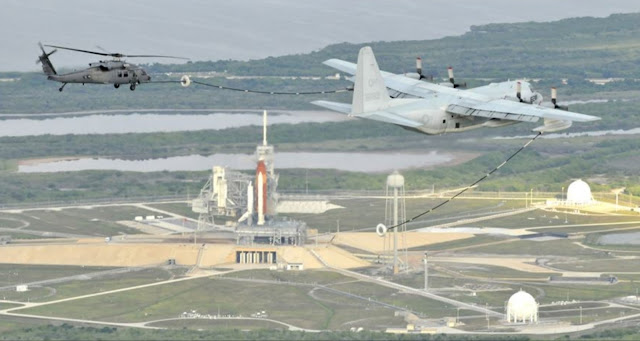Here's a concise summary of the Jolly Green Giant's mission in supporting NASA's Space Shuttle program: Most, if not all, squadrons were mobilized to aid the NASA program, excluding those activated solely for the war in Southeast Asia from the 1960s to the present day, such as the 26th ERQS.
The official program name for the Space Shuttle was the Space Transportation System (STS). Flights were sequentially numbered starting from STS-1, when Columbia launched on April 12, 1981, until STS-135, which concluded with Atlantis making its final landing on July 21, 2011, marking the end of the Shuttle program.
The rich history of the US Air Force supporting NASA's space missions, from the early Gemini missions to the recent Dragon missions, underscores the invaluable contributions of the Jolly Green Giants to the STS program since its inception.
The journey began with the formation of the 39th ARRW Det 15 at Patrick AFB on January 8, 1981, operating HH-3E helicopters. During the first shuttle flight, NASA's two-member flight crew consisted of Mission Commander John W. Young, a 51-year-old former Navy pilot with extensive astronaut experience, selected by NASA in 1962, and Pilot Robert L. Crippe, a 44-year-old former Navy pilot, chosen by NASA in 1969, for whom STS-1 marked his inaugural space journey. At the time, rescue crews wore a Det 15 patch (shown below), devoid of any reference to the shuttle, as Det 15 was assigned to the 39th ARRW.
39th Aerospace Rescue & Recovery Wing
Detachment 15
STS-1 Patch
Patrick AFB
Worn by Det 15 who were assigned to the 39th ARRW by the crews for the first Space Shuttle launch (STS-1) in 1981.
The video below shows early footage of the pararescue crews training for the recovery of NASA pilots & crew.
STS-2 test flights took place in 1981, succeeded by two more tests in 1982, STS-3 and STS-4. Operational flights commenced with STS-5, which launched on November 11, 1982. The patch design underwent a transformation with the creation of a patch that integrated an image of a shuttle orbiting the Green Giant. However, the precise date of this alteration remains unclear; it must have occurred between 1982 and 1987 when Det 15 was deactivated.
39th Aerospace Rescue & Recovery Wing
Detachment 15
Patrick AFB
The first Jolly Green Giant patch incorporating the orbiting Shuttle.
The mission was carried out by Det 15 until the 1 February 1987 when it was disbanded, however all of the crew & helicopters remained with Det 15, so they continued supporting the Shuttle missions, even though the official dates say otherwise.
used by Det 15, again with no shuttle on the patch.
(USAF Photo/SSgt. Magel)
It appears that there might be discrepancies between the official records and the accounts provided by former crew members. The activation of the 41st RQS on March 1, 1989, as a replacement for Detachment 15 of the 39th ARRW suggests a two-year gap. Accounts from ex-crew members I've corresponded with imply that Det 15 continued its operations until the activation of the 41st. Not all official records are 100% accurate and I'd take the experiences of first hand crew over official records. Furthermore, the patches created by the 41st Air Rescue Squadron, incorporating the squadron's number in the top scroll for the first time, mark an important shift in their visual representation, despite the continued use of the old HH-3E helicopters.
41st Air Rescue Squadron
Patrick AFB
This is the first patch worn by crews of the 41st between 1989 and 1993. As you can see there is three variations of the ARS patch each one slightly different & all different sizes. The one on the left is backed with hook & loop.
Following its redesignation as the 41st Rescue Squadron on February 1, 1993, the squadron underwent a significant equipment transition the subsequent year, replacing the HH-3 helicopters with the more advanced HH-60G Pavehawks. These Pavehawks played a critical role during the launch and landing phases, providing essential rescue support in the event of any mishap that might require the shuttle crew to evacuate. To ensure comprehensive assistance, for every two crew members aboard the shuttle, the USAF deploys one Pavehawk, with a doctor and two PJs (Pararescuemen) on board. Consequently, when the shuttle carries a crew of eight, the 41st RQS mobilizes four Pavehawks to fulfill their rescue obligations.
Four Pavehawks come into land after providing support to a launch. (NASA)
41st Air Rescue Squadron
Patrick AFB
This patch was a larger design and made subdued although I don't know why it was larger or subdued.
41st Rescue Squadron
Patrick AFB
This was the last shuttle patch made for supporting the NASA program.
The extensive involvement of various squadrons in supporting NASA, particularly the 301st RQS, has been notable, with some units even incorporating a Gemini pod into their official patches due to their extensive support. Additionally, the perspective provided by the Flight Doctor in the YouTube video offers valuable insights into the mission support provided by the HH-60G Pavehawks.










My dad, Joe Nall, flew rescue 2 at the first launch. We were at Myrtle Beach AFB at the time, Det. 11, I think.
ReplyDeleteThanks for the comment I hope it brought back good memories.
DeleteIndeed it did. Very proud of my dad and awed by Jolly Green crews.
ReplyDelete